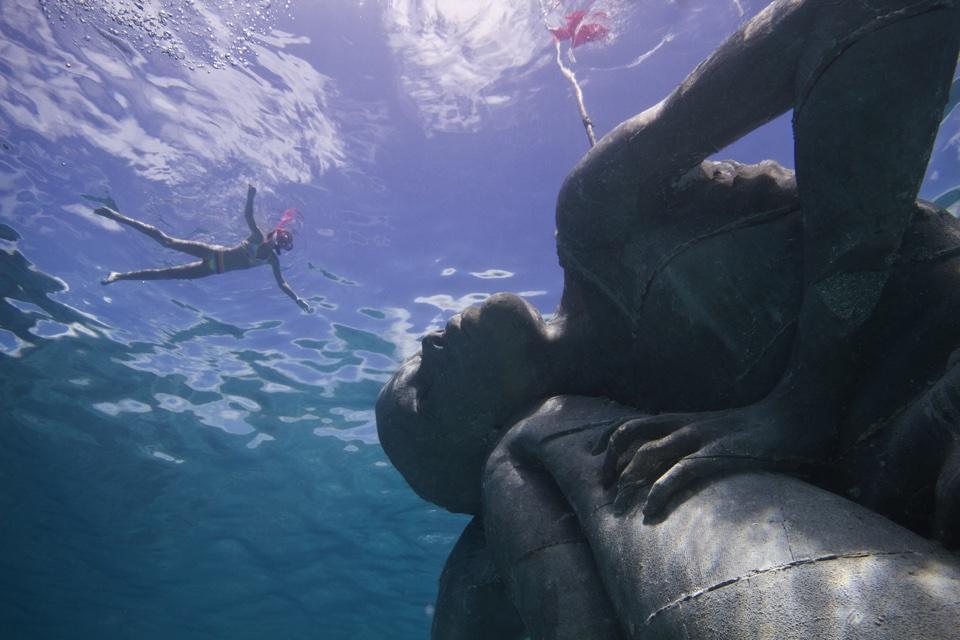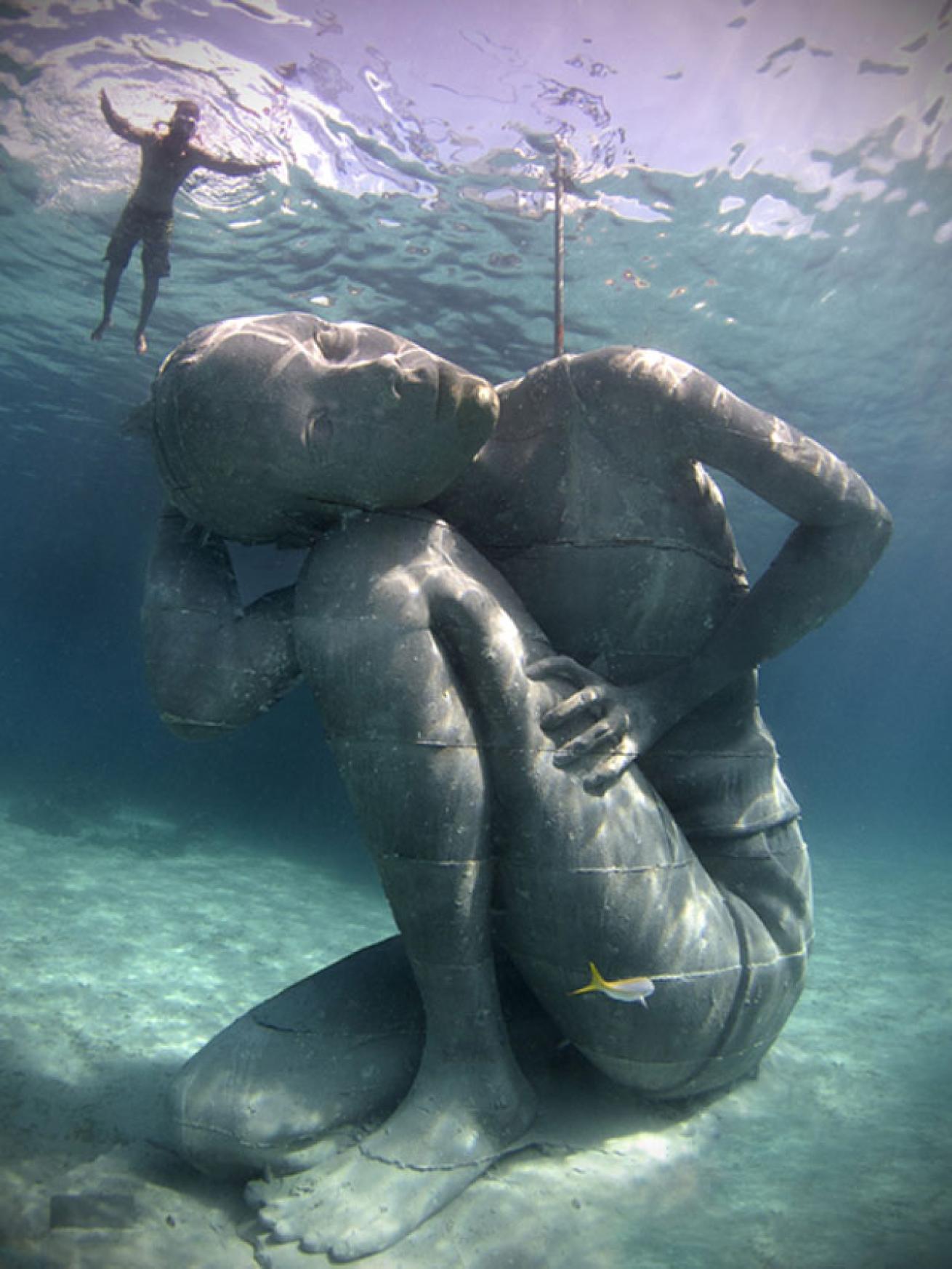The Largest Underwater Statue in the World: “Ocean Atlas” in the Bahamas
The deep blue waters surrounding the Bahamas hold many secrets, but one of their most awe-inspiring treasures is not natural—it’s a colossal piece of art. The “Ocean Atlas,” located just off the coast of Nassau, is the largest underwater statue in the world. Created by renowned sculptor Jason deCaires Taylor, this monumental work of art serves as both an artistic marvel and an ecological sanctuary, designed to foster marine life. At once hauntingly beautiful and environmentally significant, “Ocean Atlas” is more than just a statue; it is a powerful symbol of the relationship between humanity and the oceans.
A Colossal Creation

The “Ocean Atlas” was installed in 2014 as part of an ambitious project to combine art with environmental conservation. Standing at 5 meters (16 feet) tall and weighing over 60 tons, the statue depicts a young Bahamian girl kneeling on the ocean floor, seemingly carrying the weight of the sea on her shoulders. The sculpture’s name is a nod to the Greek myth of Atlas, the Titan condemned to hold up the sky. In Taylor’s reimagining, however, the weight on the girl’s shoulders symbolizes the burden humanity has placed on the oceans.
Carved in stunning detail, the statue’s expression is one of calm endurance, reflecting the quiet strength of the ocean itself. Her features are soft yet defined, her pose both graceful and powerful. The massive scale of the sculpture, which towers over divers exploring the reef below, evokes a sense of awe, compelling viewers to confront their own relationship with the marine environment.
The Artistic Vision Behind “Ocean Atlas”
Jason deCaires Taylor is no stranger to the world of underwater art. He is an environmental sculptor who has pioneered the concept of underwater museums, creating submerged sculptures that double as artificial reefs. His works, scattered across the world’s oceans, aim to raise awareness about marine conservation while providing a habitat for marine life. “Ocean Atlas” is one of his most significant and ambitious projects.
Taylor’s vision for “Ocean Atlas” was not merely to create a beautiful piece of art, but to serve as a living, breathing ecosystem. Made from pH-neutral marine cement, the statue is designed to encourage coral growth. Over time, algae and corals will colonize the sculpture, turning it into a thriving artificial reef. Fish, crustaceans, and other marine creatures will seek shelter in the nooks and crannies of the statue, helping to replenish the local ecosystem.
The sculpture also has a deeper symbolic meaning. Taylor’s choice to depict a young girl emphasizes the idea of legacy—the future generations who will inherit the oceans and the environmental challenges that come with them. By placing her beneath the sea, Taylor draws attention to the pressing issues of climate change, rising sea levels, and the degradation of marine habitats. The girl, burdened by the weight of the ocean, becomes a poignant reminder of our responsibility to protect and preserve the world’s waters.
A Dive into the Depths: Visiting “Ocean Atlas”

For those fortunate enough to visit the Bahamas, a dive to see “Ocean Atlas” is an unforgettable experience. Located near Clifton Heritage National Park, just a short boat ride from Nassau, the statue rests at a depth of about 5 meters (15 feet), making it accessible to both snorkelers and scuba divers. As you descend into the crystal-clear waters, the figure of the girl gradually emerges from the blue, a silent sentinel standing watch over the seabed.
Surrounded by vibrant coral reefs and schools of tropical fish, the underwater world around “Ocean Atlas” is teeming with life. Divers can explore the statue up close, swimming around and beneath the massive figure to appreciate its scale and detail. The serene expression on the girl’s face and the sheer size of the sculpture create an eerie, almost otherworldly atmosphere, as if she is a guardian of the ocean’s secrets.
Beyond its artistic appeal, the statue also serves an important environmental purpose. The Bahamas, like many other island nations, is vulnerable to the impacts of climate change and overfishing. “Ocean Atlas” is part of a larger effort to protect and restore the region’s coral reefs, which have been severely damaged by human activity. By creating artificial reefs like the one fostered by this sculpture, marine biologists and conservationists hope to provide a safe haven for marine life to thrive.
An Artistic Call to Action
“Ocean Atlas” is more than just a piece of art—it is a call to action. It challenges us to rethink our relationship with the oceans and take responsibility for the damage we have done to the marine environment. The sculpture’s imposing presence beneath the waves serves as a reminder that the oceans are not infinite, and the weight of our actions is heavy.
Taylor’s work invites viewers to engage with environmental issues in a way that is both emotional and intellectual. By placing his art in the ocean itself, he forces us to confront the realities of sea-level rise, coral bleaching, and habitat loss. As the girl bears the weight of the ocean, she stands as a symbol of hope and resilience, reminding us that it is not too late to reverse the damage and protect the underwater world for future generations.
Conclusion: A Melding of Art and Conservation
“Ocean Atlas” is an extraordinary fusion of art and environmentalism, bringing attention to the fragile ecosystems of the ocean while also serving as a practical solution to coral degradation. Its stunning beauty, massive scale, and symbolic message make it a must-see for divers and art lovers alike. More than that, it is a testament to the power of art to inspire change and create a lasting impact on both people and the planet.
By blending creativity with conservation, Jason deCaires Taylor’s “Ocean Atlas” invites us to look beneath the surface—literally and metaphorically—and consider what we can do to lift the weight of the ocean’s burdens.





